Designing for small bathrooms can feel like solving a complex puzzle, but it’s also a rewarding challenge that allows interior designers to get truly innovative with space-saving solutions. Whether your client has a compact guest bathroom or a tiny powder room, implementing smart design hacks can significantly enhance both functionality and aesthetics without compromising either. These strategic approaches not only create an efficient and comfortable environment but also elevate the overall user experience. Let’s explore in detail the design ideas that can transform small bathrooms into efficient, stylish retreats.
1. Pocket Doors Save Valuable Floor Space
Replacing a traditional swing door with a pocket door is a transformative step for small bathrooms. Pocket doors slide into the wall, eliminating the need for clearance space required by standard doors. This space-saving solution offers more flexibility with the bathroom layout, allowing you to maximise usable floor space, particularly in tight hallways or awkward bathroom entrances.
For example, if a bathroom is positioned adjacent to a hallway, a pocket door can streamline the access point, freeing up valuable real estate that can be used for storage or decorative elements. Moreover, pocket doors can be customised with various designs and finishes, allowing you to maintain a cohesive aesthetic with the rest of the home..
Pro Tip: In older homes, retrofitting a pocket door might seem daunting, but it’s worth the investment. Make sure to consult with a contractor to ensure the wall can accommodate a pocket door and that there’s sufficient structural support. Clients will appreciate how this solution provides an unobtrusive entry point, leading to a more spacious and uncluttered feel in their bathroom.
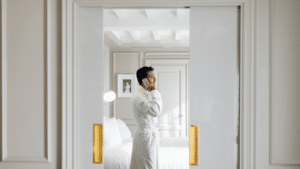
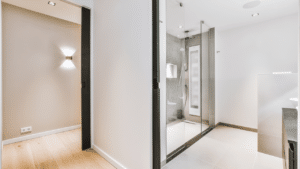
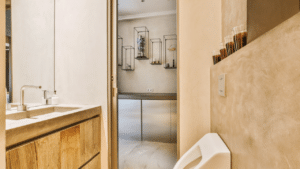
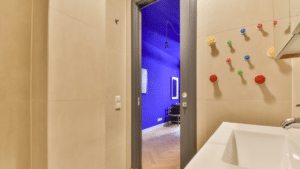
2. Large Mirrors Create the Illusion of More Space
Mirrors are an essential design tool that can make small spaces feel larger and brighter. Installing a large mirror above the sink or even along an entire wall can reflect light and visually expand the room. This trick enhances the perception of space and brightness, making the bathroom feel more inviting.
Incorporating a mirrored cabinet can also provide hidden storage for toiletries while maximising the reflective surface. This combination not only serves a functional purpose but also adds a touch of elegance to the design. For instance, a large, frameless mirror can create a seamless look, while a mirrored cabinet can double as an attractive focal point.
Pro Tip: Choose backlit mirrors for added ambiance and a modern touch. The additional lighting not only enhances the space but also provides better illumination for tasks like makeup application and shaving. This solution ensures that the bathroom remains practical while also feeling like a luxurious retreat.
3. Go High to Save Space!
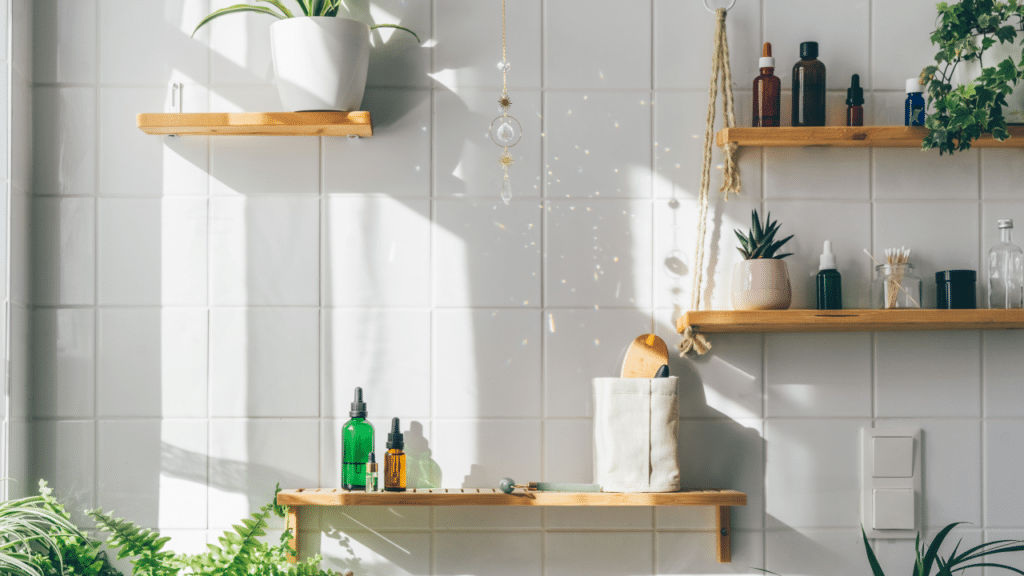
When square footage is limited, the solution is to think vertically. Floating shelves or narrow wall-mounted cabinets installed above the toilet or along empty walls can keep towels, toiletries, and decorative items within reach without crowding the floor. This approach to vertical storage is brilliant for making use of underutilised space while maintaining a stylish and organised bathroom.
For example, a series of floating shelves can be installed above the toilet to hold decorative baskets or stylish storage bins, keeping everyday items easily accessible while enhancing the design aesthetic. Adding greenery or decorative accents to the shelves can also introduce a personal touch, making the bathroom feel like a cohesive part of the home.
Pro Tip: Use decorative containers or baskets on floating shelves to store items while keeping the design visually cohesive and tidy. This not only adds practicality but also brings in texture and colour, making the space feel warm and inviting. Encouraging clients to personalise their vertical storage can lead to a more satisfying and curated space.
4. Light, Neutral Colour Schemes: Keep it Bright
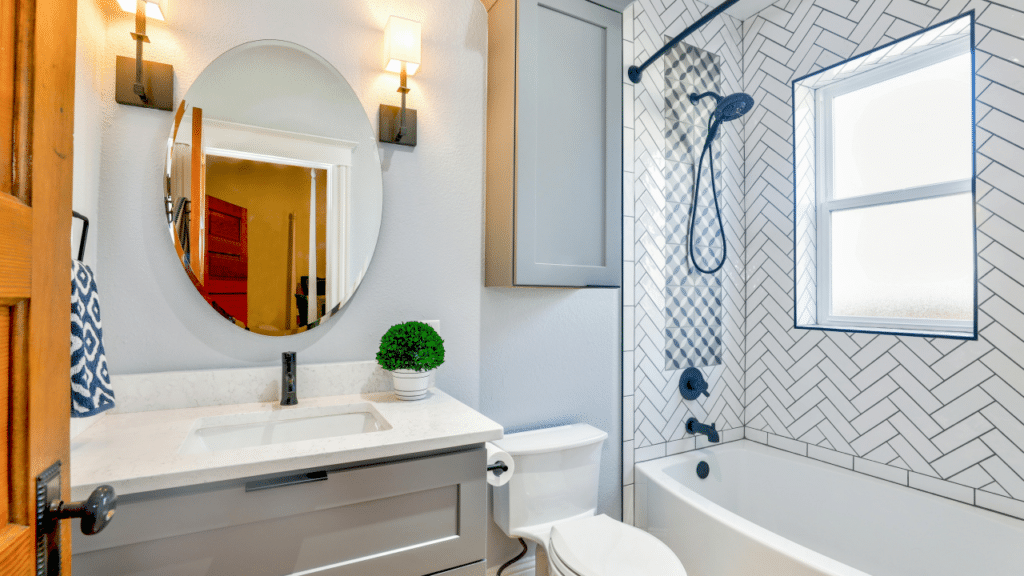
A light, neutral colour palette works wonders in small spaces. Shades of white, soft greys, and pastels reflect light and create an airier feel, making the bathroom appear larger than it is. Opting for light-coloured tiles, walls, and fixtures helps to keep the space feeling open and fresh.
For example, a pale blue or soft grey can evoke a serene atmosphere, while white fixtures and cabinetry can offer a clean, minimalist look. This approach allows clients to introduce pops of colour through accessories or towels without overwhelming the space. Keeping foundational elements neutral helps to prevent the room from feeling cramped.
Pro Tip: Choose glossy or semi-gloss finishes for paint and tiles to enhance light reflection, making the bathroom feel even brighter. Suggest to clients that they can add texture with matte finishes in smaller accents, maintaining a harmonious balance in the design.
5. Maximise Usable Space with a Corner Sink
In bathrooms where every inch counts, a corner sink can be a lifesaver. By utilising the often-unused corner space, this fixture frees up more room in the centre of the bathroom, allowing for greater freedom of movement. Pairing a corner sink with a mirrored cabinet above it can provide extra storage without overwhelming the space.
Choosing a compact, sleek design for the corner sink can keep the bathroom looking clean and uncluttered. Additionally, many corner sinks are designed to maximise functionality, featuring built-in shelving or storage underneath, which further enhances the utility of the space.
Pro Tip: When selecting a corner sink, look for options that include additional storage features or that can easily integrate with surrounding cabinetry. This can help your clients optimise every square inch of their bathroom, creating a cohesive look that enhances both style and functionality.
Crafting Chic and Functional Small Bathrooms
Designing small bathrooms is about optimising space without sacrificing style. By implementing these detailed space-saving hacks like pocket doors, large mirrors, vertical storage, light colour schemes, and corner sinks, you can help your clients create functional, beautiful bathrooms that maximise every square inch. These thoughtful design choices not only enhance the aesthetics of the space but also improve the overall user experience, making even the smallest bathroom feel luxurious and inviting.
With the right approach, your clients will not only appreciate the newfound functionality but also feel a sense of calm and relaxation in their transformed bathrooms. As designers, it’s your innovative ideas and attention to detail that will ensure these spaces become cherished retreats in their homes
Ready to take your design skills to the next level?
Explore our wide range of accredited interior design courses today, including short courses, diplomas, undergraduate degrees, and a master’s degree in interior design. Whether you are looking to deepen your knowledge or gain new industry insights, our programs empower you to create stunning, functional spaces that your clients will love!
At NDA, flexibility is key. You can study at a time that suits you, making it easier to fit your education around your lifestyle and everyday commitments. We also offer affordable tuition without compromising on quality, and our experienced tutors provide personalised support to guide you through every step of your studies. Plus, with clear progression pathways, you can easily advance from a diploma to a degree and even a master’s program, all within a supportive learning environment.
Our courses meet the highest academic standards, with diplomas accredited by AIM Qualifications Awards and degrees validated by partners like De Montfort University, Leicester. This ensures your qualification is recognised globally and opens doors to future academic and professional opportunities.
Start Your Design Journey Today
At NDA, we believe education should inspire and transform lives.
Join us to discover how studying with NDA offers a unique and transformative opportunity in the world of design education.

